Augmented Reality Market Insights, 2031
The global augmented reality market size was valued at $24.2 billion in 2021 and is projected to reach $411.4 billion by 2031, growing at a CAGR of 33.2% from 2022 to 2031.
The growing augmented reality market demand is primarily driven by advancements in AR technology. AR stands for augmented reality, which combines the real world with virtual reality and virtual environments to enhance customer experience. AR augments or adds new elements to the real environment that surrounds users. It increases the interactivity of the environment, which can also be altered digitally. AR technology is constantly changing in response to the rising use of the technology in commercial applications. This has resulted in an increase in AR chip demand in various fields like medical devices. Industry-leading organizations such as Qualcomm and NXP have introduced novel AR-powered chipsets to satisfy the changing needs of end-users, owing to the growing demand for AR chipsets. For instance, in January 2022, Qualcomm, an American multinational corporation struck a deal of partnership with Microsoft, where they agreed to develop unique semiconductors for AR glasses that will be interoperable with Metaverse apps. Such strategies by major market players are expected to increase the augmented reality market share in the future.
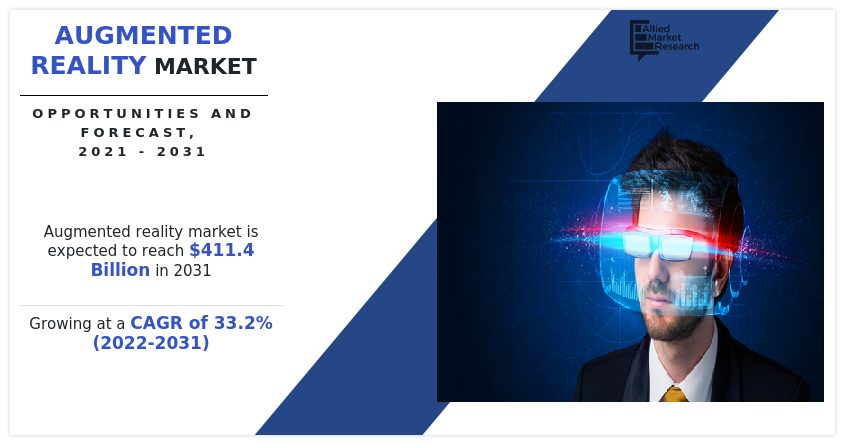
Market Drivers:
The Augmented Reality (AR) market is anticipated to witness substantial growth during the forecast period. The major factor driving the growth of the market is the development of advanced technology providing more powerful and efficient AR devices, enhanced software capabilities, and seamless user experiences. In addition, the deployment of 5G networks has facilitated faster data transfer speeds and lower latency, enabling seamless mobile and cloud-based AR applications, augmenting AR market. Furthermore, the integration of AI and machine learning offers enhanced AR through better object recognition, spatial awareness, and real-time data processing. In addition, the increase in the adoption of AR technology across various industries has further accelerated the growth of AR market size. Moreover, the surge in the use of AR-enabled wearables, such as smart glasses from companies like Microsoft and Magic Leap, offer hands-free experiences, contributing to the widespread adoption in AR industry. These factors are expected to fuel the growth of the AR technology market.
However, concerns regarding excessive use of augmented reality technology has a high chance to cause post-traumatic stress disorder and potential impact on psychology and behavior. In addition, the user’s ability to interact socially has been depleting which has led to symptoms of depression or anxiety. Thus, rising concerns like this are most likely to negatively impact the growth of the AR industry.
Despite these challenges, the augmented reality market research in augmented reality (AR) market is expected to present numerous opportunities across various sectors. Rise in the demand for retail and e-commerce platforms has led AR to allow consumers with virtual try on products, such as clothes, makeup, or furniture, before purchasing, with companies like IKEA and L'Oréal using AR for virtual home setups and makeup trials. In addition, the augmented reality statistics show that AR improves product discovery by allowing consumers to point devices at products for instant information and reviews. personalized shopping experiences provides enhanced AR with product demos, virtual fitting rooms, and interactive store displays. Furthermore, the improved product discovery through visual search, allows consumers to point their devices at a product for instant information and reviews.
Moreover, the surge in the adoption of AR in healthcare sector helps in assisting surgeons with precise surgeries through overlays of digital information, providing medical training with virtual simulations, and supporting patient rehabilitation with real-time feedback on exercises. In addition, the upsurge in the use of AR in education and training institutions are benefiting from AR through immersive learning experiences that bring subjects like biology, physics, and history to life. Augmented Reality provides virtual field trips and simulations that help students understand complex topics, whereas companies utilize it for employee training by replicating real-life tasks. The augmented reality industry report highlights the growing presence of AR in these sectors as key contributors to provide remunerative augmented reality market opportunities for market growth.
For instance, on May 30, 2024, Alphabet's Google and augmented reality startup Magic Leap formed a strategic technology partnership to create immersive experiences blending the physical and digital worlds. The partnership combined Magic Leap's expertise in optics and device manufacturing with Google's technology platforms. Although details were scarce, the collaboration hinted at Google's potential return to the AR/VR market, which it had largely yielded to Meta and Apple.
Moreover, the increase in use of AR in gaming and entertainment has created more immersive experiences, allowing users to interact with virtual elements in the real world, making entertainment more engaging and interactive. In addition, AR enhances live events, such as concerts and sports, by overlaying interactive content in real time. In addition, rise in adoption of AR in real estate sector for virtual property tours, allows potential buyers to explore properties remotely, while architects use it for visualizing designs in real spaces before construction begins. In manufacturing, AR supports technicians by providing step-by-step maintenance guides, enhances assembly lines with live instructions, and facilitates design and prototyping by allowing visualization of products in 3D prior to building physical models. In addition, the increase in the use of AR in tourism and travel industries allows travelers to explore destinations through interactive maps, virtual tours, and real-time information, enriching their journeys.
Furthermore, the surge in the adoption of AR in automotive industry offers enhanced driver safety and experience, with features like heads-up displays, navigation overlays, and real-time hazard detection, making driving more efficient and safer. In addition, there in upsurge in the use of AR in advertising and marketing, offering interactive and virtual campaigns that engage consumers, allowing them to visualize products in real time and create personalized, memorable experiences. Furthermore, rise in the adoption of AR in the hardware and software development sectors is driving innovation, enabling the creation of more advanced AR tools, platforms, and applications that improve productivity, enhance user experiences, and open new avenues for the growth of the industries worldwide.
For instance, on December 12, 2024, Hon Hai Technology Group (“Foxconn”) partnered with Porotech with to enter the AR glasses market, leveraging Porotech's GaN technology and Foxconn's services. They aim to produce high-performance, compact AR display solutions. Foxconn established a MicroLED wafer processing line in Taichung, with mass production starting in Q4 2025, positioning Taiwan as a key hub for AR glasses and MicroLED technologies. This move strengthens Foxconn's competitive edge in the AR market.
Market Trends Insights
Augmented reality market insights indicate that the augmented reality market is anticipated to witness several noteworthy trends. The growing popularity of AR is one of the significant trends fueling the market expansion. The increase in use of smartphones and other smart devices has led to the surge in the demand for AR applications which are easily accessible to consumers, expanding beyond entertainment and gaming to include sectors such as healthcare, retail, and education. Furthermore, there is a shift in preference toward delivering high quality AR experiences. Companies are emphasizing on enhancing AR systems with high-resolution displays, precise tracking, and minimal latency, leading to more immersive and realistic interactions. For instance, AR-enabled devices like Microsoft’s HoloLens and anticipated products like Apple’s AR glasses are contributing to more sophisticated, seamless AR experiences.
For instance, on January 22, 2025, Samsung Electronics, in collaboration with Google's Alphabet, announced their entry into the AR glasses market. Following their Project Moohan partnership, the two companies worked together on AR glasses, aiming to co-develop the Android XR operating system. TM Roh, Samsung's Mobile Experience division head, confirmed the collaboration It emphasized their focus on achieving high quality and readiness quickly.
In terms of market dynamics, the AR landscape is evolving rapidly. This trend encompasses continuous advancements in hardware, including the creation of wearable devices and augmented reality glasses, as well as software platforms that provide companies with the necessary tools to deploy AR solutions. In addition, there is growing demand for AR applications across diverse industries, prompting investments from major players such as Microsoft, Apple, Google, and Facebook. These market leaders are driving research and development, forming strategic partnerships, and acquiring smaller AR companies to maintain their competitive edge, offering more affordable AR solutions, reducing the cost barriers and enabling smaller businesses to implement AR in their operations.
For instance, on January 8, 2025, Amentum and Jujotech announced a partnership to accelerate the development of AR and AI technologies. This collaboration aimed to enhance productivity and operational efficiency by combining Amentum's engineering and AR solutions with Jujotech's AR and AI software expertise. The partnership focused on improving industrial maintenance and operational effectiveness in defense, while also adapting these technologies for logistics, manufacturing, and transportation. Kurt McHenry, Director of Amentum’s Mission Solutions business group, highlighted their shared vision of creating innovative, secure, and scalable solutions.
For instance, on Mayr 31, 2024 , Magic Leap announced a strategic technology partnership with Google to bring immersive AR experiences to market. This highlighted the potential synergies from combining Magic Leap’s optics and manufacturing with Google’s technologies. Although details were scarce, the companies intended to collaborate on AR solutions. This partnership followed Google’s unveiling of Project Astra, showcasing the future of AR glasses with seamless digital integration.
Another notable trend in the market is rise in popularity of e-commerce platforms using AR. The integration of AR into e-commerce platforms offers customers with enhanced shopping experiences. With AR, consumers can virtually try on clothing, preview furniture in their homes, or see how makeup products would appear on their skin. For instance, companies like IKEA and L’Oreal have leveraged AR to engage users and improve their purchasing decisions, creating a more interactive and personalized shopping environment. This integration of AR into e-commerce not only enhances customer satisfaction but also boosts online sales. As AR technology becomes more accessible, price points have significantly improved, allowing a broader audience to adopt AR devices and software. AR has become more budget-friendly with the launch of mobile AR applications and more affordable AR devices. This decline in cost, along with the increase in variety of AR options available, has contributed to making the technology more accessible and has driven its widespread use. In addition, the surge in the adoption of AR technology in industries like healthcare, automotive, and education is expected to see significant growth in the upcoming years, further broadening the scope of AR applications.
For instance, on February 12, 2025, Anduril signed an agreement with Microsoft to take control of the military AR project, Integrated Visual Augmentation System (IVAS). Initially based on Microsoft's HoloLens, IVAS had faced delays and technical issues. Anduril took over production, hardware and software development, and delivery timelines, while Microsoft focused on cloud infrastructure and AI support via Azure. The agreement awaited approval from the US Department of Defense.
Competitive Analysis
Some of the leading augmented reality market players are Google LLC, Microsoft, DAQRI, Niantic Inc, Ptc Inc., Apple Inc, Magic Leap Inc, Seiko Epson Corporation, TreeView, and CXR. These key players have adopted various strategies, such as product portfolio expansion, mergers & acquisitions, agreements, geographical expansion, and collaborations, to increase their market penetration and strengthen their foothold in the augmented reality market.
For instance, on September 12, 2024, XRAI partnered with Vuzix at the Augmented Reality Policy Conference in Washington D.C. By integrating XRAI Glass into Vuzix Blade 2™ and Vuzix Shield™ smart glasses, users benefited from real-time subtitles for better communication in noisy environments and multilingual conversations. Dan Scarfe, CEO of XRAI, expressed excitement about the collaboration, marking XRAI's entry into defense and security sectors. The launch event featured live demonstrations and real-time subtitling using XRAI Stream.
The global augmented reality market is segmented on the basis of component, device type, end-use and region. By component, the market is sub-segmented into hardware and software. By device type, the market is sub-segmented into head-mounted display, handheld display and others. By end use, the market is sub-segmented into retail, healthcare, manufacturing & construction. By region, the market is analyzed across North America, Europe, Asia-Pacific, and LAMEA.
By component, hardware sub-segment accounted for the highest revenue share and is predicted to show the fastest growth during the forecast period. Owing to the growing acceptance of augmented reality technology around the world, the hardware component of the market is expected to develop faster than the software segment. According to data from research firm International Data Corporation (IDC), in 2021, the total AR/VR headsets shipped 2021 was an increase of 92.1% over the previous year. In May 2022, Meta (formerly Facebook) opened its first hardware store in California to give its consumers a first-hand experience of its hardware products such as virtual reality headsets and augmented reality goggles and glasses. With this, the company has set the wheel in motion for metaverse-the next evolution of the Internet and will contribute to increasing the augmented reality industry size.
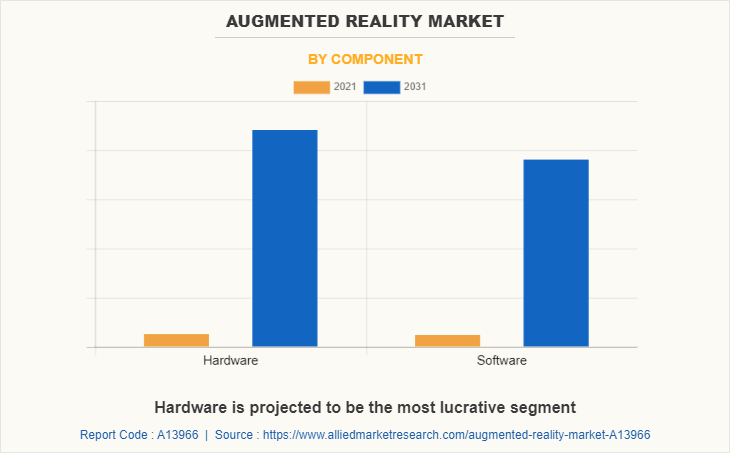
By device type, the handheld devices sub-segment is predicted to be the most dominant and head-mounted display is anticipated to show the fastest growth during the forecast period. The rise in the demand for mobile augmented reality in the retail sector to improve customers' shopping experiences is considered as the factor for the growth of the AR market. The adoption of AR in social media apps such as Snapchat (filters), Facebook, and Instagram will drive demand for more rich content in mobile AR for social media.
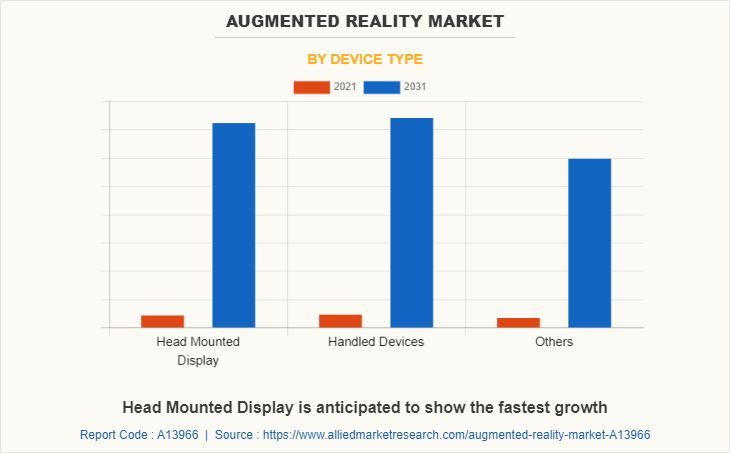
By end-use, the media and entertainment sub-segment is predicted to be the most dominant and the healthcare sub-segment is anticipated to have the fastest growth during the forecast period. The adoption of the AR-based solution in the healthcare industry is increasing considerably. The augmented reality model offers hands-free solutions and AI-based diagnostic tools. AR healthcare apps can be useful for surgeons while conducting minimal invasive surgeries by locating a tumor or a relatively abnormal disorder in an organ and saving patients’ lives seamlessly. The growth in surgeries across the globe is one of the major factors that help AR technology to grow fast in the healthcare sector in the forecast period.
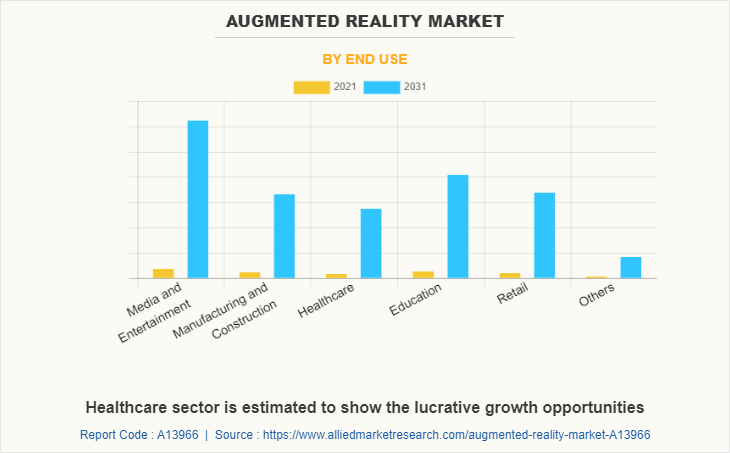
Regional Review
By region, Asia-Pacific is anticipated to be the most dominant and the most lucrative region for industry growth. The booming manufacturing sector in China and Japan is expected to drive the augmented reality market in the region to new heights. This region's advancing gaming industry has also seen tremendous expansion, contributing to APAC's rising need for augmented reality technologies in AR technology market. Additionally, increased investments in commercial augmented reality applications are likely to contribute to the market's growth in APAC. Furthermore, Japan's burgeoning healthcare and automotive industries are expected to fuel demand for AR technology in the region.
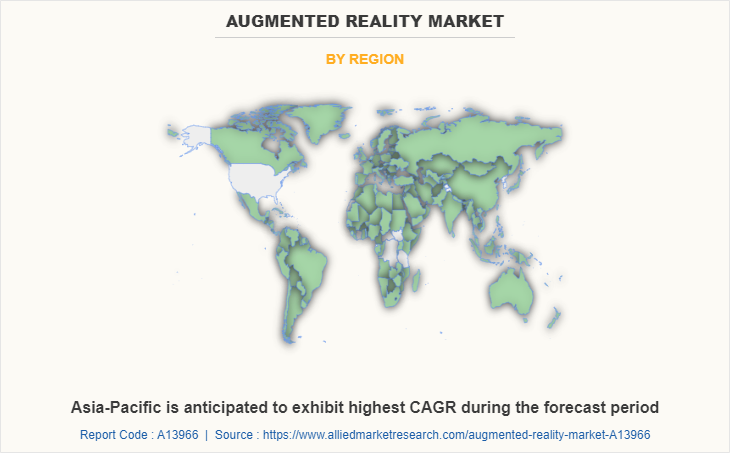
For instance, on 10, 2024, Blippar partnered with Arabian Business Machines (ABM) to bring AR technology solutions to the Saudi Arabian market. Ghazi Alotaibi, ABM's General Manager, highlighted the partnership's significance for digital transformation in the region. This partnershiped expressed excitement about collaborating with ABM to create world-class XR projects. The aimed to leverage Blippar's AR technology and ABM's market reach to empower brands and businesses with immersive experiences and advanced content creation tools, driving digital transformation in Saudi Arabia.
Key Benefits for Stakeholders
- The report provides an exclusive and comprehensive analysis of the Global augmented reality market trends along with the augmented reality market forecast.
- The report offers an in-depth augmented reality market analysis, highlighting key drivers, and restraints of the market. It is a compilation of detailed information, inputs from industry participants and industry experts across the value chain, and quantitative and qualitative assessment by industry analysts.
- Porter’s five forces analysis helps analyze the potential of the buyers & suppliers and the competitive scenario of the market for strategy building.
- The report entailing the augmented reality market analysis maps the qualitative sway of various industry factors on market segments as well as geographies.
- The data in this report aims at market dynamics, trends, and developments affecting the augmented reality market share.
Augmented Reality Market Report Highlights
| Aspects | Details |
| By Component |
|
| By Device Type |
|
| By End Use |
|
| By Region |
|
| Key Market Players | Seiko Epson, DAQRI, Magic Leap, Microsoft, Apple, Google LLC, PTC Inc., TreeView, Blippar Limited, Niantic, Inc. |
Analyst Review
Increase in demand of augmented reality market technology in healthcare sector is a major factor projected to drive the augmented reality market growth during the forecast period. In addition, growing demand for 3D imaging in healthcare sector and application in manufacturing plants to increase efficiency by reducing production downtime are further expected to boost the market share growth in the forecast years. However, growing augmented reality security and privacy concerns will present a significant technical challenge to the market. The high cost associated with research and development for cutting-edge augmented reality technical solutions and lack of skilled or trained professionals and technological expertise, particularly in developing and underdeveloped economies will further restrain market expansion. Rising digitization, especially in developing countries, coupled with a stronger focus on technology, and the development of the internet of things in healthcare sector will generate more lucrative market growth opportunities.
Among analyzed regions, Asia-Pacific is anticipated to be the most dominant and the most lucrative region for augmented reality market. The growing manufacturing sector in China and Japan and incorporation of augmented reality technology in different product manufacturing industries is expected to drive the augmented reality market in the region to new heights. The region has also experienced tremendous expansion in gaming industry and use of augmented reality technologies in virtual games. This factor has also contributed to the rising need for augmented reality technologies, thereby accelerating market growth even further.
The leading applications of augmented reality are healthcare, manufacturing, retail, and media & entertainment.
Asia-Pacific is the largest regional market for augmented reality.
The estimated industry size of augmented reality is $411,396.90 million by 2031.
The upcoming trends in augmented reality are AR based image filters, AR animations, deep learning works for AR shopping, and its growing applications across healthcare sector.
Google LLC, Microsoft, DAQRI, Apple Inc. are the top companies to hold the highest market share in the augmented reality market.
Loading Table Of Content...


